Tashkent Zoo
Tashkent Zoological park is a cultural, educational and research establishment. The Tashkent Zoo was founded in 1924 on the basis of the small menagerie which existed at that time at an art museum on the territory of a former country summer estate of the governor general, at the initiative of scientific biologists; an area of about 3 hectares was allocated for the Zoo. By the end of the 1940s construction of the Tashkent Zoo had been completed. The zoo housed about 200 species of animals.
In 1994, the Government of the Republic of Uzbekistan made the decision to construct a new Zoo to meet all modern requirements and Standards. In 1997, on the Day of Independence, the new Zoo, located near the Botanical garden, began operations. The new Zoo is 22,7 hectares in size.
All open air cages, whenever possible, were of a landscape type, and corresponded to all modern requirements. Since 1998, the Tashkent Zoo has been a member of EARAZA (Euro-Asian Regional Association of Zoos and Aquariums). In 1997, after opening the new Zoo, the quantity of animals totaled 85 species. In the year 2004, this number has increased to 349 (nearly 3000 individual animals). One feature of the new Zoo is its sea aqua systems in the Aquarium.
In the sea aqua systems, you can view sea animals: sharks, murens, fish, polyps, etc. Today, in the Zoo, live: mammals - 58 species, 189 specimens; birds - 74 species, 472 specimens; reptiles and amphibians - 26 species, 81 specimens; fish - 191 species, 2141 specimens. The specialization of the Tashkent Zoo is the reproduction of birds of prey. Good results have been achieved on the breeding of birds of prey - the white-headed griffon, black griffon and condor.
Large-scale scientific work on the cultivation of rare and endangered species of animals is being conducted. The Zoo has close relations with 46 Zoos all over the world.













